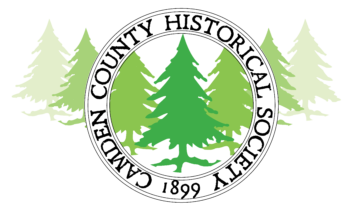Enslaved Africans Sold Here
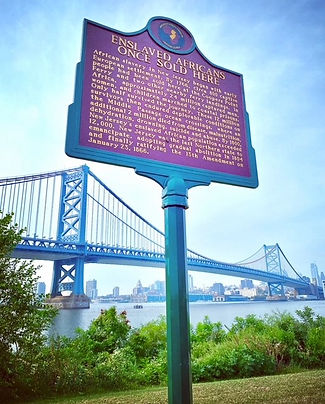
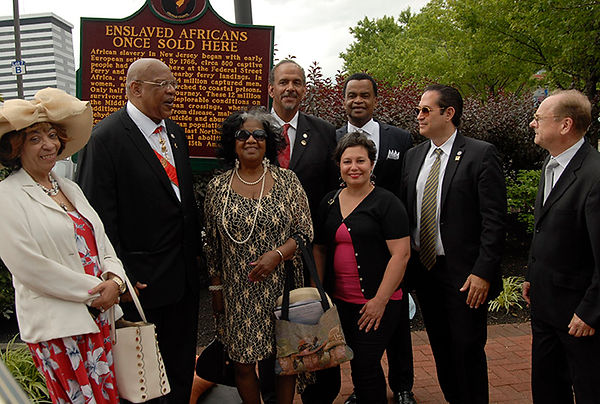
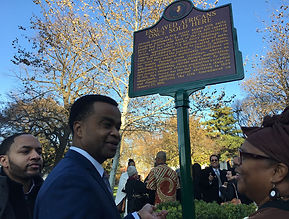
Enslavement and the Trans-Atlantic Human Trade Marker Dedication, October 4, 2021
An historic Middle Passage port marker was unveiled Wednesday morning near the city marina to emphasize Perth Amboy’s role in the trans-Atlantic human trade, the forced transporting of about 12 million captive Africans across the Atlantic Ocean from Africa to the Americas, including many who perished along the way.
The marker, located near the city’s historic Ferry Slip, notes that near the site enslaved Africans disembarked in Perth Amboy, one of the main ports in eastern New Jersey at that time. The marker’s placement was selected based on historical research of where captive Africans arrived in the city.
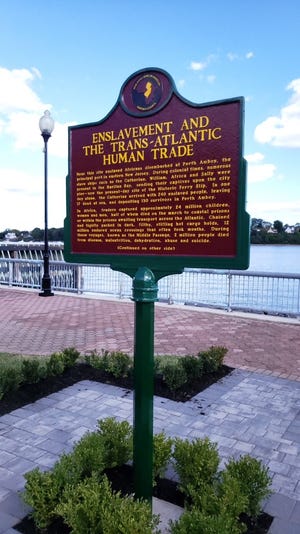
Cooper Poynt Enslaved Africans Marker Dedication, September 25, 2020
On Friday, September 25, 2020, the Camden County Historical Society unveiled a third historic marker acknowledging the sale of enslaved Africans in Camden during the 1700s. Located at Cooper Poynt Park, the marker remembers the Cooper Poynt Ferry site, where slave sales were once held. Between 1727 and 1766, perhaps as many as 800 enslaved Africans were sold at the three Camden ferry landings. The Camden County Historical Society erected two others markers at the Walt Whitman Center to mark the Cooper’s Ferry site and at the corner of Delaware Avenue and Federal to remember the Federal Street Ferry site. The full history of Camden sites where slave sales were held can be read below.

Federal Street Enslaved Africans Marker Dedication, June 17, 2019

Cooper Street Enslaved Africans Marker Dedication, November 27, 2017
On November 27, 2017, the Camden County Historical Society erected the first of three markers at sites in Camden where enslaved Africans were once sold. Click on the news links for articles covering this event. More about these former ferry sites is written below.
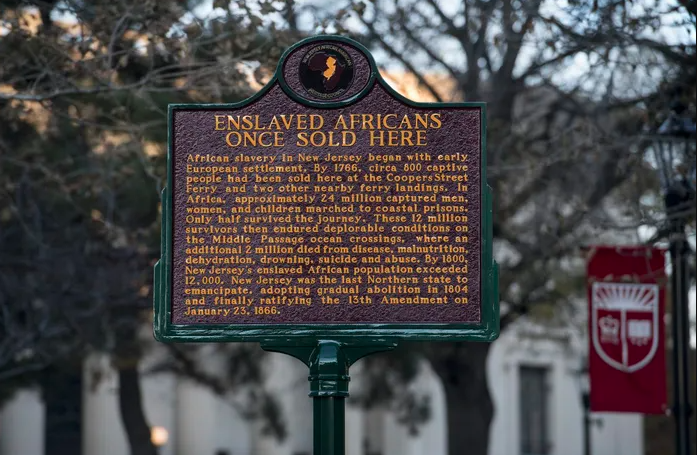
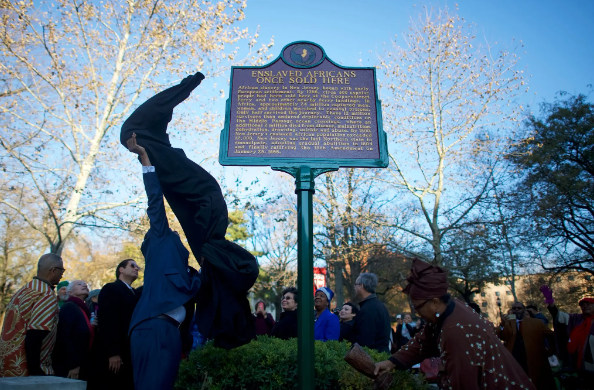
Cooper Street Ferry
“To be sold by John Connor, a parcel of young Negroe Men, Boys and Girls, at reasonable Rates, are to be seen at William Coopers in the Jersey, and at Joseph Huggs at Gloucester.” A portion of an advertisement that appeared in the September 14 and October 5, 1727 editions of the American Weekly Mercury, representing the earliest slave sales at the ferries in New Jersey and advertised in the newspaper. Earlier sales may have occurred, but no documentary records of them appear to exist.
Ferry service for moving people across the Delaware River between New Jersey and Philadelphia, beginning in the late seventeenth century, are the roots from which the City of Camden grew. The ferry terminals on the Jersey shore grew into small settlements, complete with hotels, warehouses, liveries, and stores. The terminals often served as points of commerce for public sales and auctions. The first ferry established between Philadelphia and New Jersey operated from the foot of present-day Cooper Street to Arch Street in Philadelphia. Daniel Cooper began ferry operations at this location in 1695. Philadelphians knew this service as “the old ferry,” indicating its antiquity. Daniel maintained the ferry until his death in 1715. It is unclear who provided the service following Daniel’s death, but in 1727, his son William, had become the owner/operator. During William’s first year of tenure, two slave sales occurred at the ferry: the one cited above by John Connor in September-October and another sale in December: “Two very likely Negroe Men to be sold, (they are at William Coopers in New-Jersey, over against Phiadelphia) Inquire of Andrew Bradford.”
While the auctions held at three different ferries in Camden appear to be limited, these sales likely introduced upwards of 300 new slaves to West New Jersey and eastern Pennsylvania. The regular movement of slave vessels up the Delaware River began in the 1750s, arriving at docks along the Philadelphia side. The London Coffee House, located at Front and Market streets in Philadelphia, held regular slave auctions on that side of the river during the 1750s and 1760s. Between 1757 and 1766, 1300 African slaves reportedly disembarked from the Guinea ships. In addition to the newly arrived Africans, the Cooper ferries served as a venue for selling previously owned single slaves and small groups of males and females held in bondage. The arrival of new slaves during the pre-Revolutionary years must have had a profound effect on the local agrarian economy, industrial enterprises, and general commerce.
It also swelled the messaging volume of ardent abolitionists like Benjamin Lay (who died in 1759), Anthony Benezet, and John Woolman, among others, leading to the imposition of import duties, the banning of all slave importation, and, finally, New Jersey’s Gradual Manumission Act of 1804.
Cooper's Point
“To be sold by Garrett and George Meade, at Roberts’ Ferry opposite this city, A parcel of stout, likely, young Gold Coast SLAVES.” This is a portion of an advertisement that first appeared in the August 9, 1764 issue of the Pennsylvania Journal, the notice all stated “THE Negroes from this country are esteem’d better, than from any other part of the coast, and those will be sold on very reasonable terms for cash or short credit.”
Ferry service for moving people across the Delaware River between New Jersey and Philadelphia, beginning in the late seventeenth century, are the roots from which the City of Camden grew. The ferry terminals on the Jersey shore grew into small settlements, complete with hotels, warehouses, liveries, and stores. The terminals often served as points of commerce for public sales and auctions. The second ferry established operated from Coopers Point to the Shackamaxon/Fishtown section of Philadelphia and later to Arch Street in the city. While William Cooper, the founder, originally operated this ferry service, it descended down through the Cooper family during the eighteenth century. Between 1728 and 1769, Benjamin Cooper, William’s grandson, owned and operated the ferry, but between 1762 and the end of 1764, he leased the operation to a Philadelphian named Roberts. During this lease period, at least two slave sales occurred, ranging from a William Hill offering “Two young Negroes; a Lad about 19 Years old, who is a tolerable good Cook, and can wait a House; and a Girl about 17, who can wait a house also” to an entire shipload on the sloop Jenny in August 1764. All of these sales took place at “Roberts’ Ferry.” Samuel Cooper, son of Benjamin Cooper, assumed control of the ferry in 1765. During his first year, one slave was offered for sale: “A Likely Negroe Girl, about 14 Years of Age,” perhaps a holdover from the Roberts’ tenure of the ferry. Samuel retired to his farm in East Camden, where his two sons, Benjamin Cooper and William B. Cooper, actively engaged in aiding fugitive slaves make their escape. The Camden area was known as Station A on the Underground Railroad in New Jersey.
Federal Street Ferry
“To be sold by Garrett and George Meade, at Roberts’ Ferry opposite this city, A parcel of stout, likely, young Gold Coast SLAVES.” This is a portion of an advertisement that first appeared in the August 9, 1764 issue of the Pennsylvania Journal, the notice all stated “THE Negroes from this country are esteem’d better, than from any other part of the coast, and those will be sold on very reasonable terms for cash or short credit.”
“To be sold by Daniel Cooper, in the Jerseys, A Likely Negroe fellow, about 26 years of age, well acquainted with country business, and has had the small pox and measles.” This is a portion of the first advertisement for the sale of a slave at Daniel Cooper’s ferry near the foot of Federal Street. It appeared in the May 2, 1751 edition of The Pennsylvania Gazette and the ferrymaster himself is selling the man in bondage.
Ferry service for moving people across the Delaware River between New Jersey and Philadelphia, beginning in the late seventeenth century, are the roots from which the City of Camden grew. The ferry terminals on the Jersey shore grew into small settlements, complete with hotels, warehouses, liveries, and stores. The terminals often served as points of commerce for public sales and auctions. William Cooper, son of Daniel, and operator of the Cooper Street Ferry beginning in 1727, sold 100 acres of riverfront property to his son, Daniel, in 1744, including the site for a ferry terminal near the end of present-day Federal Street. Daniel began his ferry operations within a few years of acquiring the land from his father. Four additional advertised slave sales occurred at this ferry, all during 1761. The first appeared in the May 7, 1761 issue of The Pennsylvania Gazette, comprising “A Negro Man, and two New Negroe Boys, who are to be sold by Willing, Morris, and Company.” These slaves had just arrived from Barbados in the ship William and Mary. Another sale conducted by Stocker and Fuller of “A Parcel of likely NEGROES” appeared in the June 11, 1761 edition of the Pennsylvania Journal. The largest sale of Africans was advertised in the August 29, 1761 issue of the Pennsylvania Journal. Conducted by Thomas Riche, David Franks, and Daniel Rundle, this group of would-be slaves had just arrived on the schooner Hannah, and consisted of “A Cargo of likely Negroes, just imported in said Schooner, directly from the Coast of Guinea.” The final sale notice appeared in the pages of The Pennsylvania Gazette for September 24, 1761. John Harris advertised to sell “three likely Negroes, viz. two Men about 20 Years of Age, and a Boy about 13.”
The sale of slaves ended with those in 1761 as the following year the Colonial Assembly passed an act imposing a tariff on the importation of slaves. New Jersey was the last colony to do; Pennsylvania and New York already had their tariffs in place to discourage any further importation of slaves from Africa or from the Caribbean islands.
